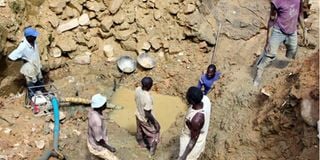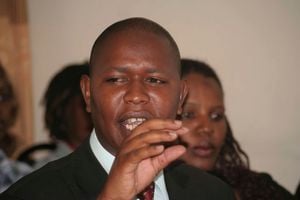2021 brought hope for gold wealth

Gold minors searching for gold at Lirhembe mines Ikolomani Constituency in Kakamega. An exploration firm announced it had found viable deposits valued at Sh164 billion.
The year 2021 saw the gold mining industry in Western Kenya shine a ray of hope on the residents after an exploration firm announced it had found viable deposits valued at Sh164 billion.
The mining plan was given a major boost following the recent launch of construction works for a gold refinery in Kakamega County.
During the year, Shanta Gold Limited, through its regular updates, indicated that exploration showed there could be more gold deposits than the projected 1.03 million ounces.
The firm said it made a conversion of 117,600 ounces (3,333.9 Kgs) of inferred gold resources from its first phase of drilling that ended on June 30.
It added that it was targeting to convert another 1.1 million ounces of the mineral from the second and third drilling phases whose results are expected in the first quarter of 2022.
Shanta Gold acquired the project from Barrick Gold in 2020 and it is exploring for the mineral in Shisele, Isulu and Shirumba, commonly referred to as the Lihranda corridor.
Residents believe the region is sitting on large deposits of gold that have not been explored.
Should the viability of the mine be determined, residents believe the valuable metal will lift them out of poverty.
At the moment, the villagers are relying on small-scale mining whose yields are low, amid exploitation by middlemen.
For many years, they have watched in disbelief as the mining rights kept changing hands between international firms since the colonial era.
Now, they are pegging their hopes on Shanta Gold, and the firm’s move to establish a gold refinery at Lidambitsa on the busy Kisumu-Kakamega highway has given them confidence.
Mr Benedict Khayego, 52, from Bushangala, says he has been a miner for 38 years, having started when he was 14.
He says they lack machines to undertake large-scale mining, relying on the holes that were made by Europeans who conducted exploration and mining in the area in the 1950s.
With a refinery imminent, artisanal miners are excited at the prospect of selling a gramme of gold at Sh6,000 directly to the company.
This is Sh1,000 more than what they are paid by middlemen.
Ms Scholastica Daudi and Ms Mable Chanzu, are among the few women who are engaged in gold mining.
They say there is hope of a lot of gold being found despite the challenges artisanal miners regularly encounter.
Since 1932, when colonialists discovered the mineral in Ikolomani, European exploration firms conducted extensive exploration and mining up to 1952 before they left.
In one of its latest regular updates this year, Shanta Gold said it has found the fourth hole with visible gold at Bushangala after reaching a depth of 3,205 metres.
Through the update, Shanta Gold Ltd CEO Eric Zurin noted that the firm is almost halfway through its total planned infill drilling programme in western Kenya for this year.
Potential
He observed that the Lihranda corridor represents significant potential for his firm’s business. The corridor is believed to have 1.03 million ounces of NI43-101 inferred gold resources.
The firm is in its second drilling phase out of the planned three phases before it determines viability and establishes a mine.
Should a mine be established, it is believed the deposits could be mined for 10 years.
Shanta Gold said it plans to complete 45 per cent of the total planned infill drilling for 2021, indicating that the new year will see more drilling.
The ambitious western Kenya project covers 1,162 km² of the highly prospective and under-explored greenstone archaean Busia-Kakamega Gold Belt in western Kenya.




